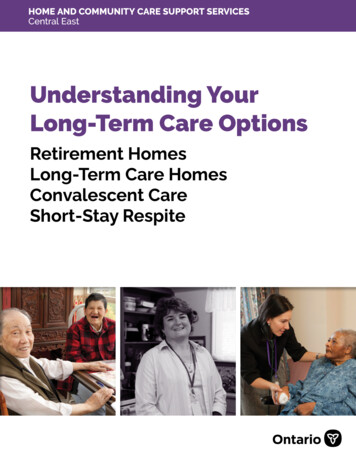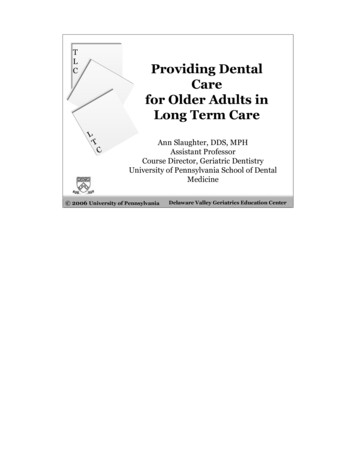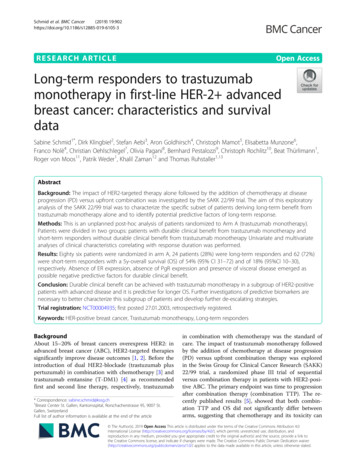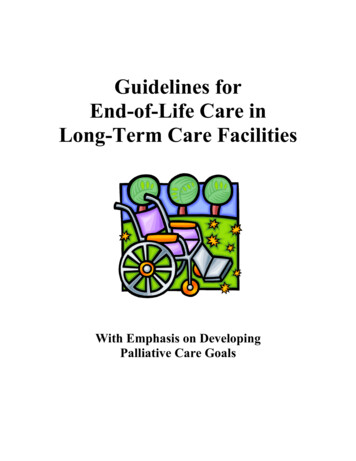
Transcription
.Understanding YourLong-Term Care OptionsRetirement HomesLong-Term Care HomesConvalescent CareShort-Stay Respite
.
.IntroductionPlacement OptionsTable of Contents45-6Retirement HomesLong-Term Care HomesConvalescent CareShort-Stay RespiteApplying for Placement into a Long-Term Care Home7-9Eligibility CriteriaAccommodations for a SpouseVeterans AffairsThe Application Process10-12Consent and CapacitySubstitute Decision-MakerGuidelines for Substitute Decision-MakingHealth AssessmentHome Choice FormChoosing a Long-Term Care HomeCost of Care in a Long-Term Care Home1213Rate ReductionFinancial Supports to Assist Admission14-17Patients Receiving Provincial Income AssistanceMarried ResidentSpousal Co-paymentMaximizing Income on Involuntary SeparationFederal Income Security Programs for SeniorsOther Income Assistance Options for SeniorsWhat to Look For in a Long-Term Care HomeWhen a Long-Term Care Bed Becomes AvailableAdmission Day1717-1819-20What to ExpectWhat to TakeAfter You Move In21Long-Term Care ACTION LineLong-Term Care Homes in the Central East regionAPRIL 202122-26Understanding Your Long-Term Care Options3
Understanding Your Long-Term Care OptionsHome and Community Care Support Services Central East provides a single pointof access for people of all ages to several home and community care servicesservices. We offer in-home and school health care services, information and referralto community agencies, as well as admission to long-term care homes. Patientsbeing assessed for long-term care must meet the eligibility requirements (seeEligibility Criteria, page 8).Facing the decision that you can no longer manage to live in your own homeis never easy. Home and Community Care Support Services Central East hasprepared this package to help you and your family explore and make decisions thatbest meet your needs.There are different types of options available to you, with varying admissionprocedures and fee structures. This package contains detailed information aboutthe services and types of care provided in the various long-term care homes withinthe Central East region.While you are waiting for admission into a long-term care home, Home andCommunity Care Support Services Central East can provide support to you andyour family. Our services are paid for by the Ministry of Long-Term Care, andinclude a range of in-home health care services and specialized programs.The long-term care process can be emotionally stressful and sometimes causestrain to relationships. The emotional and health care needs of the caregiver areequally important and should be considered when moving through the processof transitioning to long-term care. Home and Community Care Support ServicesCentral East offers a program for caregivers called Powerful Tools for Caregivers.This workshop series helps caregivers: Understand the importance of self-careManage difficult emotions like guilt, anger and depressionIdentify and reduce personal stressLearn effective communication skills to express needs and concernsMaster caregiving decisionsFor more information about this program or to register for a workshop please go towww.ceselfmanagement.ca or call 1-866-971-5545To ensure that you have explored all options, please read the following packagethoroughly. Additional information sheets are attached. Please do not hesitateto contact your Home and Community Care Support Services Central East carecoordinator for more information.4.
Placement Options.Retirement HomesRetirement homes are privately owned and operated. They are suitable for seniorswho are independent but may still require some assistance. They can provideyou with housekeeping, meals, and laundry. They may also provide assistancewith bathing, dressing, medications, and general support and supervision. Youapply directly to a retirement home for admission. Accommodation costs are notregulated and do vary.When considering a retirement home, you should ask for a tour and discuss yourindividual care requirements and any extra services that you may require with theadministrator.For your convenience, a list of retirement homes can be obtained from your carecoordinator or by visiting The Ontario Retirement Home Regulatory Authoritywebsite at www.rhra.ca.Long-Term Care HomesIf you can no longer manage while receiving services at home/in a retirementhome or supportive housing setting, it may be time to consider long-term care.Care coordinators can help you and your family through the process of applying foradmission to any long-term care home in Ontario.long-term care homes are publicly funded and operated by the Ministry of Healthand Long-Term Care. They can provide health care and services to you when yourneeds cannot be met within the community. Available services include: Nursing and personal careAssistance with activities of daily livingTreatment and medication administrationMealsLaundry servicesSocial/recreational programslong-term care homes are licensed and regularly inspected by the Ministryof Health and Long-Term Care. Standards of care are governed by provinciallegislation to ensure that the care, programs, and services offered by long-termcare homes are of the highest quality.Smoking is not permitted in any of the long-term care homes in the Central Eastregion. You may smoke outside provided you are independently mobile, do notrequire supervision to ensure safety, and when smoking, you are no closer than nine(9) metres to the long-term care home. Some long-term care homes have restrictedsmoking to a designated outdoor smoking area.Understanding Your Long-Term Care Options5
Additional Programs AvailableWithin Long-Term Care HomesConvalescent CareFollowing surgery or serious illness, you may not require hospital care, but you maynot yet be ready to safely return home. Convalescent care provides care to peoplewho require specific medical and therapeutic services in a supportive environment.If your doctor has said your health condition is stable and you do not need to bein the hospital, convalescent care may be a good solution. The same eligibilitycriteria as admission to a long-term care home applies for convalescent care beds.Convalescent care is not intended to serve individuals needing complex continuingcare or palliative care.Convalescent care is usually provided to you for 30 to 45 days, up to a maximumof 90 days per calendar year. A care coordinator from Home and Community CareSupport Services Central East can provide more information about this programand your eligibility.Short-Stay RespiteShort-stay respite is designed to support family caregivers by providing relief fromtheir caregiving responsibilities. Respite care is generally planned in advance.The maximum length of stay is 60 days at a time, up to a maximum of 90 daysper calendar year. Admission to the short-stay program can be made throughHome and Community Care Support Services Central East by calling your carecoordinator.6.
Applying for Placement into a Long-Term Care Home.To begin the application process for admission to a long-term care home, pleasecontact your local Home and Community Care Support Services Central Eastbranch. An experienced care coordinator will help you and your family through theprocess. They can provide information and support that will allow you and yourfamily to make decisions that best meet your needs.BranchContactPeterborough(includes Port Hope,Campbellford, Lindsay,and Haliburton -430-3308Toll free1-800-263-3877Understanding Your Long-Term Care Options7
Eligibility CriteriaA Home and Community Care Support Services Central East Care Coordinatormust assess and determine your eligibility for long-term care. In order to beeligible for admission to a long-term care home in Ontario, you must be 18 yearsor older, have a valid Ontario health card, and you must have health care needsthat can be met in a long-term care home. You must also need either nursingcare, assistance with activities of daily living, on-site supervision, or monitoring atfrequent intervals throughout the day to ensure your safety and well-being.Also, to be eligible for admission to a long-term care home in Ontario, it mustbe determined that the publicly funded community-based services, includingretirement/supportive housing, convalescent care or other caregiving, supportor companionship arrangements available to you are not sufficient to meet yourneeds.If you do not meet the eligibility criteria, Home and Community Care SupportServices Central East will notify you in writing and assist you in locating alternativeservices as well as make appropriate referrals on your behalf with your consent.While Home and Community Care Support Services Central East determines youreligibility for admission, each long-term care home has the right to approve yourapplication based on their ability to meet your needs. You will be notified in writingby the long-term care home if your application for admission is not accepted.Accommodations for a SpouseOnce you have been admitted to a long-term care home, your spouse or partnermay be admitted in order to live with you.Your spouse or partner must be at least 18 years of age, have a valid Ontario healthcard, and have health care needs that can be met in a long-term care home.Spouses or partners of residents of a long-term care home whose individual healthcare needs meet the eligibility criteria may qualify for a special “spousal priority” tore-unite with their spouse or partner in the long-term care home.Varying health care needs may prevent you from sharing accommodations withyour spouse or partner. For instance, either you or your spouse or partner mayrequire a special care unit and the other may not. Keep this in mind when touringlong-term care homes and meeting with your care coordinator. More informationabout Spousal Co-payment for Accommodation is available on page 14 of thisbooklet.8.
.Veterans AffairsThe Ministry of Health and Long-Term Care, in collaboration with Veterans AffairsCanada, has established priority access beds for veterans in selected long-termcare homes. Eligibility for this program is determined by Veterans Affairs Canada.Please inform your care coordinator if you are a veteran. Once Veterans AffairsCanada has determined that you are eligible, you can be placed on a waiting list forthese beds.Veterans Affairs Canada may also subsidize the residence co-payment undercertain circumstances. Check with your Veterans Affairs Canada office for moreinformation.Contact Veterans Affairs Canada at 1-866-522-2122 (toll-free) Monday to Friday, 8:30to 4:30, local time.Understanding Your Long-Term Care Options9
The Application ProcessWhen you think it is time to apply to a long-term care home, A Home andCommunity Care Support Services Central East Care Coordinator will come to yourhome or the hospital to assess your health care needs and determine if you areeligible.To apply to a long-term care home, the following information is required:Consent and CapacityThe decision to be admitted to a long-term care home, like treatment decisions formedical care, requires the voluntary and informed consent of a capable person. Inthe case of admission to a long-term care home, you are considered capable if youunderstand all the information that is needed to make a decision to be admittedinto a long-term care home, as well as the consequences of either making or notmaking that decision.A capacity evaluation will determine if you are capable of making the decision. TheHealth Care Consent Act, 1996, states that the evaluator must be a qualified healthpractitioner (e.g., physician, nurse, social worker). To protect your individual rights,the law presumes you are capable unless determined otherwise.Evaluators are required to advise applicants if they are found incapable andto inform you of your right to appeal the finding. A review by the Consent andCapacity Board may uphold or overturn the decision.If the applicant is found to be incapable with respect to the decision for admissioninto a long-term care home, consent may be given or refused by your substitutedecision-maker.Substitute Decision-MakerThe substitute decision-maker is determined by legislation in the following order: Guardian of the Person, (court ordered)Power of Attorney - Personal CareBoard-appointed representativeSpouse or partnerChild or parentBrother or sisterAny other relativeRelative by marriage or adoption10.
The Application Process (continued).Guidelines for Substitute Decision-MakingIf you are the authorized substitute decision-maker for an incapable person,the Health Care Consent Act, 1996, outlines the following principles for making adecision about admission to a long-term care home: Give or refuse consent in accordance with relevant wishes expressed whilethe person was capable. If you do not know the person’s prior capable wishesapplicable to the circumstances, or if it is impossible to comply with the wish, youshall act in the incapable person’s best interests. In deciding what the incapable person’s best interests are, you shall consider:i. the values and beliefs that you know the person held when capable;ii. any wishes expressed by the person with respect to admission to a longterm care home; and the following factors: the impact of admission to the long-term care home on the quality of theperson’s life; the impact of not being admitted to the long-term care home on thequality of the person’s life; whether the benefit the person is expected to obtain from admission to thelong-term care home outweighs the risk of negative consequences to himor her; whether a course of action that is less restrictive than admission to thelong-term care home is available and is appropriate in the circumstances.If you are a substitute decision-maker, before giving or refusing consent foradmission to a long-term care home on behalf of an incapable person, you areentitled to receive all of the information required in order to make the decision.Health AssessmentThis form can be filled out by your family doctor, a registered nurse, or a nursepractitioner. It is important for Home and Community Care Support Services CentralEast to have your most up-to-date medical information to assist with determiningeligibility. This will ensure that your medical needs can be met by the long-termcare homes you have chosen. You do not have to pay for a health assessment formto be completed.Understanding Your Long-Term Care Options 11
Home Choice FormWe strongly recommend that you and a family member tour each long-term carehome you’re considering before making a decision. Virtual tours of all 68 CentralEast long-term care homes are available on our website: www.healthcareathome.ca/centraleast. A long-term care home checklist is included in this package,please number your choices. Make sure you sign and date the form.Choosing a Long-Term Care HomeThe application process includes the selection of your preferred long-term carehomes. Once you are deemed eligible, an application is made to the long-term carehomes you have selected.You may select up to five (5) long-term care homes anywhere in Ontario. Yourposition on the waiting list for the long-term care homes you have selected isdetermined by the dates when Home and Community Care Support ServicesCentral East received your choices and established your eligibility. Admission toa long-term care home depends on prioritization of needs according to provincialcriteria.If your health status changes while you are at home, please inform your carecoordinator. Your situation will be re-assessed to determine your priority forplacement.Provincial regulations require that you accept the first bed offered in any of thelong-term care homes that you have selected. If you refuse a bed offer, your namewill be removed from all long-term care home waiting lists. You will be able tore-apply in 12 weeks or sooner if there is a significant change in your condition. Itis very important that you select long-term care homes that you are prepared tomove into. If you accept a long-term care bed that is not your preferred choice, youwill remain on the waiting list for your other home(s), with the same position date onthe waiting list.Waiting for placement into a long-term care home from hospital is not ideal,however if you are in the hospital and are unable to return home to wait forplacement, you may select five (5) long-term care homes in Ontario. Whenchoosing your homes, the care coordinator will provide you with informationregarding the estimated wait times for the homes to assist you in making decisionsthat will facilitate your placement from hospital as soon as possible. Choosing somelong-term care homes with a shorter wait time is always recommended in orderfor you to move to a long-term care home in a timely manner. A care coordinatorwill work with the hospital team to ensure a smooth transition into a long-term carehome.12.
Cost of Care in a Long-Term Care Home.The Ministry of Long-Term Care pays for the health care you receive, but you mustpay for the accommodation costs of the long-term care home. Accommodationrates are adjusted annually by the Ministry of Health and Long-Term Care and arethe same throughout Ontario. Please see the attached Accommodation Rate Sheet.Rate ReductionA rate reduction may be available to you if you are applying for basicaccommodation and have a limited annual income. Your Home and CommunityCare Support Services Central East Care Coordinator will provide you with theappropriate paperwork. You must provide the completed paperwork to the longterm care home upon admission. Once you are admitted to a long-term care home,your application will be processed and the reduction is retroactive to the date ofyour admission. A Comfort Allowance is set annually by the Ministry of Long-TermCare to allow an individual some spending money to cover personal needs such asclothing and haircuts. This application is reviewed annually.Any financial issues or arrangements that you may have should be discussed withthe long-term care home staff.Understanding Your Long-Term Care Options 13
Financial Supports to Assist Admission.Receiving Provincial Income AssistanceUpon admission to a long-term care home, if you are receiving provincial incomeassistance (Ontario Works benefit or Ontario Disability Support Program benefit),you can apply for a rate reduction. This will assist in covering the cost of a basicaccommodation and still leave you with a Comfort Allowance. This application iscompleted upon your admission and once processed, it will be retroactive to thedate of your admission.Married Resident - Both Spouses Over 65 Years OldWhen you or your spouse are a resident in a long-term care home and one of youlives in the community, either you or your spouse may apply for an exceptionalcircumstances reduction. The purpose of the reduction is to assist the spouse wholives in the community with their living expenses. Proof of income for both you andyour spouse, as well as proof that all sources of income have been exhausted, isrequired.Spousal Co-payment for AccommodationAll two-bed rooms occupied by spouses, including those defined as semi-private,are now defined as standard rooms. While living in these rooms, spouses will becharged only up to the maximum of basic accommodation co-payment.If spouses are sharing a room and cannot afford the basic accommodationco-payment, both spouses are eligible to apply for rate reduction.When one spouse no longer occupies a bed in the shared two-bed room, otheroptions are available which can be discussed with a Home and Community CareSupport Services Central East Care Coordinator and/or long-term care homeadministrator.14
.Married Resident - One Spouse Under 65 Years OldIf you or your spouse are under the age of 65, and either you or your spouse havebeen admitted to a long-term care home, the Ministry of Long-Term Care policiesregarding rate reductions differ depending on your situation.If you are living in a long-term care home and are under the age of 65, and havelittle or no income, you may apply for an exceptional circumstances reduction,based on your income only.If you are under the age of 65 and live in the community, and your spouse lives in along-term care home, have little or no income left to support yourself after payinglong-term care home fees, and are between the ages of 60 and 64, you may beeligible for the Spouse’s Allowance. If you are under the age of 60, you may qualifyfor provincial income assistance and should apply.Maximizing Income on Involuntary SeparationFinancial support may be available when you or your spouse is admitted to a longterm care home, or when both you and your spouse are admitted to a long-termcare home, but do not share the same room. If both you and your spouse are overthe age of 65, and either or both of you have limited income, an application shouldbe made immediately for involuntary separation. This can be done through the OldAge Security (OAS) office. The OAS office will consider the separation as strictlyfinancial and will review each income separately.To apply for involuntary separation, you and your spouse must be living separately,with either you or your spouse living in a dwelling that is not maintained by theother, due to reasons beyond your control. The application cannot be completeduntil after you or your spouse is permanently admitted to a long-term care home.Understanding Your Long-Term Care Options 15
Federal Income Security Programs for Seniors.Old Age Security PensionThe Old Age Security (OAS) pension is a monthly payment available to mostCanadians aged 65 or older. You must apply to OAS to receive this benefit. You canapply for the OAS pension six months before your 65th birthday.Guaranteed Income SupplementThe Guaranteed Income Supplement (GIS) is a monthly benefit paid to OAS pensionrecipients who have little or no income in addition to OAS. The GIS is based onyour annual income. You must initially apply for the GIS and then you can usuallyautomatically renew it when completing your income tax return.Spouse’s AllowanceThe Spouse’s Allowance is paid to a person who is between 60 and 64 yearsof age, and who is either a spouse, widow or widower of an OAS pensioner. Toreceive the Spouse’s Allowance, you must have lived in Canada for at least 10 yearsafter turning age 18. The Spouse’s Allowance is based on your income. If eitheryou or your spouse is an OAS pensioner, the Spouse’s Allowance can increaseyour combined income to the guaranteed annual income for a couple. If you area widow or widower, the Spouse’s Allowance will increase your income to thefederal guaranteed income. The Spouse’s Allowance is reduced on a sliding scale,depending on whether other income is received.Service CanadaService Canada Centres are full service centres offering a mix of information andtransactional services. Scheduled Outreach Sites offer the same services on ascheduled basis. For more details on any of the federal programs, including whenthe service centres are open, call 800-O-CANADA (800-622-6232) or visit theService Canada Centre website at: www.servicecanada.gc.caOther Income Assistance Options for SeniorsSome private medical plans may offer assistance with the cost of placementinto a long-term care home. Check with your group medical insurance plan todetermine if you are eligible for assistance.16
What to Look For in a Long-Term Care Home.Like neighbourhoods, each long-term care home has a unique atmosphere. It isimportant to consider if the “feel” of the long-term care home is right for you and ifthey can meet your specific health care needs. You should visit several long-termcare homes prior to making your choice(s) as well as visit their website. Virtual tourvideos for all 68 long-term care homes in the Central East region are available onthe Home and Community Care Support Services Central East website atwww.healthcareathome.ca/centraleast. The long-term care home checklistincluded with this package will assist you during your visits.When a Long-Term Care Bed Becomes AvailableThe Long-Term Care Bed OfferA home and Community Care Support Services Central East Care Coordinator willcontact you or your substitute decision-maker when an appropriate bed becomesavailable in one of your chosen long-term care homes. It is important for Home andCommunity Care Support Services Central East to have all telephone numbers andinformation regarding times when you or your substitute decision-maker may beaway.When you are offered a bed in a long-term care home, it is required that yourespond within 24 hours. If you do not respond within the 24-hour timeframe, thiswill be considered a bed refusal and bed refusal regulations will be in effect (see Ifyou decide to turn down a bed offer on page 18 for more information).If you are residing in the community and you accept the long-term care bed offer,you should be prepared to move the following day. If you accept a bed in a longterm care home that is not your first choice, you have the option of remaining onthe waiting list for your preferred long-term care home(s) while you reside in thatinitial long-term care home.Understanding Your Long-Term Care Options 17
When a Long-Term Care Bed Becomes Available (continued)If you decide to turn down a bed offer at any of the long-term care homes youhave applied to, your name will be removed from all waiting lists. If you are in yourown home or other type of accommodation in the community, you may re-apply in12 weeks or sooner if there is a change in your condition. If you are in a long-termcare home, you will also be removed from all long-term care home waiting lists if abed in another long-term care home is offered and you refuse, but there is no timelimit on when you may re-apply.If you are in the hospital and are unable to return home to wait for placement,be prepared to accept the first long-term care bed of your choice when offered.Again, this will be a secondary placement until a vacancy becomes availablein your preferred long-term care home. Home and Community Care SupportServices Central East and the hospital team may assist you with arranging yourtransportation to a long-term care home.If you accept a long-term care bed but are unable to arrange immediateadmission, you can hold the bed for up to five (5) days (a daily accommodation feeis applied).If, after 5 days, you decide not to be admitted, you must still pay the chargesfor that 5 day period in which the bed was held. For daily accommodation rates,please refer to the attached Accommodation Rate Sheet.18.
Admission Day.What to ExpectWhen you tour the long-term care (long-term care) home of your choice, youshould inquire about their admission process, as they may vary. If you still havequestions, you can ask your care coordinator.On the day of your admission, the long-term care home will contact your familydoctor for confirmation of your medical orders. The long-term care home will obtainall prescribed medications from their pharmacy. A doctor is required to visit andexamine you within seven (7) days of your arrival. You should ask your doctor if heor she will continue your care after admission to a long-term care home.You and your family will be given an orientation of the long-term care home’sprocedures and you will be asked to sign a Standard Admission Contract. Youwill also be advised about the Resident and Family Councils. If you would like,arrangements can be made with the long-term care home to sign a StandardAdmission Contract prior to the day of your admission.The following documents will be required on admission day: Ontario health cardSocial Insurance Number cardAny other health insurance cards (e.g., Blue Cross)Copy of Notice of Income Tax Assessment (if requiring a rate reduction)Copy of Power of Attorney for Property and Personal Care (if available)Copy of Advance Directives (if completed)Blank void cheque or bank account number of your financial institutionUnderstanding Your Long-Term Care Options 19
What to TakeOn the day of admission, take things that you will need immediately. The rest ofyour clothes and non-essential items can be brought once you have settled in.Clothes: nightwear, socks, panty hose, undergarments, dresses, pants, tops, shirts,and sweaters. All clothes should be machine-washable. Jogging suits are warm,easy to care for, and stand up to many washings. Most long-term care homes DONOT arrange for dry cleaning. The long-term care home will label your clothes foryou, with the exception of short-stay admissions.Assistive Devices: wheelchairs, walkers, and braces. Please label all assistivedevices before taking them to the long-term care home.Toiletries: hairbrush, comb, deodorant, shampoo, toothbrush, razor, etc.Glasses and Dentures: If possible, engrave your first initial and last name on allglasses and dentures.Personal Items: You may wish to take pictures and familiar articles, such as afavourite afghan or bedspread, to personalize your room. Please check with thelong-term care home before bringing any furniture items or electrical appliances(e.g., radios or televisions). All personal items must be labelled. Earphones or aheadset may be required for radios and televisions if you are sharing a room.The following items should NOT be taken with you: Large sums of money (some long-term care homes may offer banking services)Precious jewelry, figurines, artwork, and family heirloomsFood that is not kept in closed containersSharp objects such as scissors20.
After You Move In.Moves are always difficult and require a period of adjustment. No place will be likeyour own home, therefore some compromise will be necessary. However, it canalso be a time of new beginnings, new friends, and new interests.If a problem arises, it is best if you and/or your family member di
Understanding Your Long-Term Care Options Home and Community Care Support Services Central East provides a single point of access for people of all ages to several home and community care services services. We offer in-home and school health care services, information and referral to communit










